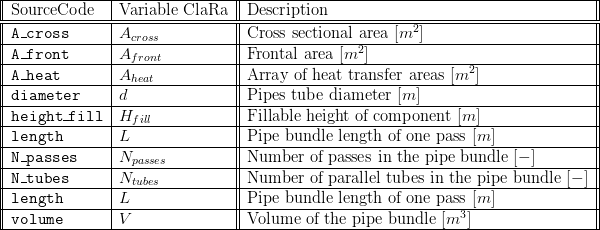PipeGeometry
Created Wednesday 10 October 2012
This model defines the basic geometric parameters of a tube bundle.
1. Purpose of Model
The PipeGeometry model gives a description of the geometric properties of a pipe bundle. This geometry definition is used by L2 control volumes.
2. Physical Insight
The volume and heat transfer area of the pipe bundle are calculated according to the properties shown in the next list:
- Diameter of the component
- Length of the component (one pass)
- Number of tubes in parallel
- Number of passes of the internal tubes
3. Limits of Validity
Lengths and diameters of the passes should be greater than zero.
4. Nomenclature

5. Governing Equations
5.1 System Description and General model approach
The model defines the geometrical elements needed in control volume models of the level of detail L2 with the shape of a tube or a tube bundle.
The general pipe geometry is displayed in the figure below with its most relevant parameters.

5.2 Governing Model Equations
The volume and areas in equations (1) to (3) consider the standard formulas for volumes and areas of cylindrical geometries together with the number of parallel tubes  in the stack and the number of passes per pipe
in the stack and the number of passes per pipe  . As shown in the figure above.
. As shown in the figure above.
The volume  is calculated by relation in Eq..1
is calculated by relation in Eq..1

The frontal area is determined by Eq. 2.

The cross sectional area is equivalent to the frontal area.


As this quality is not of relevance for this geometry, the nominal horizontal area is set to a constant value of
 .
.
The vector of the heat transferring area  has the length
has the length  . Thus, the only entry is the lateral surface of the pipe bundles computed by Eq. 5.
. Thus, the only entry is the lateral surface of the pipe bundles computed by Eq. 5.

As this quality is not of relevance for this geometry, the fillable height of the component is set to a negative constant value of

6. Remarks for Usage
Whenever the block's volume or its cross section is zero or negative an assert will raise an error message.
- A_cross > 0
- volume > 0
8. Validation
9. References
10. Authorship and Copyright Statement for original (initial) Contribution
Author:
DYNCAP/DYNSTART development team, Copyright 2011 - 2022.
Remarks:
This component was developed during DYNCAP/DYNSTART projects.
Acknowledgements:
ClaRa originated from the collaborative research projects DYNCAP and DYNSTART. Both research projects were supported by the German Federal Ministry for Economic Affairs and Energy (FKZ 03ET2009 and FKZ 03ET7060).
CLA:
The author(s) have agreed to ClaRa CLA, version 1.0. See https://claralib.com/pdf/CLA.pdf
By agreeing to ClaRa CLA, version 1.0 the author has granted the ClaRa development team a permanent right to use and modify his initial contribution as well as to publish it or its modified versions under the 3-clause BSD License.
11. Version History
20.02.2012 - v01 - Initial implementation - Friedrich Gottelt, XRG Simulation GmbH
Backlinks: ClaRa:Components:HeatExchangers:HEXvle2vle L3 1ph BU ntu ClaRa:Components:HeatExchangers:HEXvle2vle L3 1ph BU simple ClaRa:Components:HeatExchangers:TubeBundle L2
